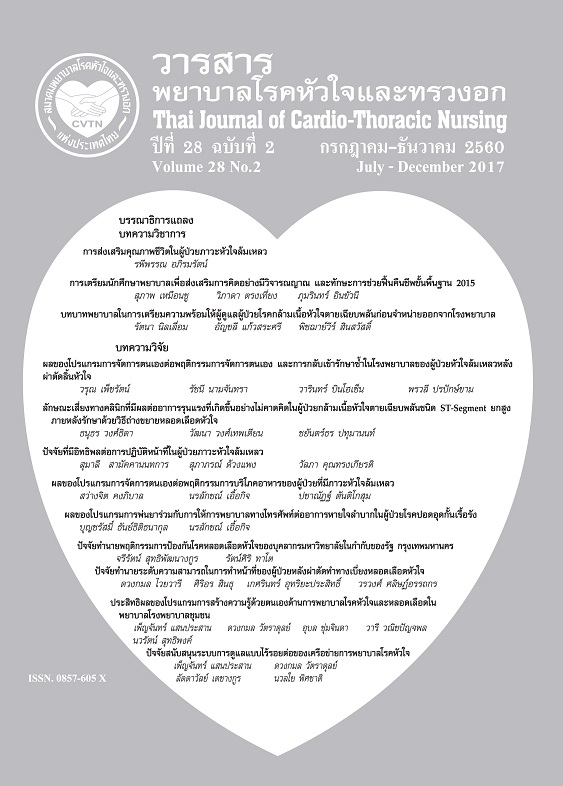ลักษณะเสี่ยงทางคลินิกที่มีผลต่ออาการรุนแรงที่เกิดขึ้นอย่างไม่คาดคิดในผู้ป่วยกล้ามเนื้อหัวใจตายเฉียบพลันชนิด ST-Segment ยกสูงภายหลังรักษาด้วยวิธีถ่างขยายหลอดเลือดหัวใจ = Clinical risks for unexpected events after primary percutaneous coronary...
Keywords:
กล้ามเนื้อหัวใจตายเฉียบพลันชนิด ST segment ยกสูง, การถ่างขยายหลอดเลือดหัวใจแบบ Primary, อาการรุนแรงที่เกิดอย่างไม่คาดคิด, การเสียชีวิตในโรงพยาบาล, Acute STEMI, primary percutaneous coronary Intervention, unexpected events, in- hospital deathAbstract
การวิจัยเชิงพยากรณ์นี้มีวัตถุประสงค์เพื่อศึกษาลักษณะเสี่ยงทางคลินิกที่มีผลทำให้ผู้ป่วยกล้ามเนื้อหัวใจตายเฉียบพลันชนิด ST segment ยกสูง (STEMI) ที่ได้รับการรักษาด้วยวิธีถ่างขยายหลอดเลือดหัวใจแบบ Primary Percutaneous Coronary Intervention: (pPCI) เกิดอาการรุนแรงที่ไม่คาดคิด ได้แก่ หัวใจห้องล่างเต้นเร็วผิดจังหวะรุนแรงใน 72 ชั่วโมง หัวใจหยุดเต้นใน 72 ชั่วโมง เกิดไตเสื่อมหน้าที่เฉียบพลันต้องทำ hemodialysis ใน 5 วันและเสียชีวิตในโรงพยาบาลใน 72 ชั่วโมง กลุ่มตัวอย่างเป็นผู้ป่วย STEMI ที่ได้ pPCI เข้ารับการรักษาในหอผู้ป่วยหนักโรคหัวใจโรงพยาบาลตติยภูมิแห่งหนึ่ง ระหว่างปี 2555 ถึง 2558 ศึกษาย้อนหลังโดยใช้ case record form บันทึกข้อมูลจากเวชระเบียน วิเคราะห์ข้อมูลด้วยสถิติ non parametric test for trend และ ordinal logistic regression
ผลการศึกษาพบว่าผู้ป่วย STEMI ภายหลัง pPCI มีจำนวน 217 ราย จำแนกตามระดับความรุนแรงของอาการที่ไม่คาดคิดออกเป็น 3 กลุ่ม คือ 1) กลุ่มที่ไม่เกิดอาการรุนแรง (ร้อยละ 79.7) 2) กลุ่มที่เกิดอาการรุนแรงมากกว่า 1 อย่างแต่ไม่เสียชีวิต (ร้อยละ 6.5) และ 3) กลุ่มที่เสียชีวิตใน 72 ชั่วโมง (ร้อยละ 13.8) ภายหลัง multivariable analysis พบว่า ลักษณะเสี่ยงทางคลินิกที่ทำให้ผู้ป่วยมีโอกาสเกิดอาการรุนแรงไม่คาดคิดในระดับที่รุนแรง คือ หัวใจหยุดเต้นก่อนหรือระหว่าง pPCI (OR= 3.33, 95% CI 1.15 to 9.59, p=0.026) เส้นเลือดตีบมากกว่า 1 เส้น (OR= 3.44, 95% CI 1.33 to 8.91, p=0.011) มีการหายใจล้มเหลวต้องใช้เครื่องช่วยหายใจก่อนหรือระหว่าง pPCI (OR= 4.20, 95% CI 1.54 to 11.48, p=0.005) ได้รับการใส่ IABP (OR= 12.99, 95% CI 2.58 to 65.44, p=0.002) และเมื่อย้ายกลับมาถึง CCU มีค่า Sp O2 น้อยกว่าร้อยละ 90 (OR= 25.96, 95% CI 5.42 to 124.48, p<0.001)
จากผลการศึกษาครั้งนี้ ได้ให้แนวทางแก่บุคคลากรที่ดูแลผู้ป่วยภายหลัง pPCI ในการวางแผนการดูแลเพื่อการคัดกรองผู้ป่วยที่มีปัจจัยเสี่ยงและเตรียมเครื่องมือที่ต้องใช้ในภาวะฉุกเฉินหรือแจ้งให้ญาติทราบถึงโอกาสที่ผู้ป่วยอาจเกิดอาการในระดับที่รุนแรงเพิ่มขึ้นได้
Clinical risks for unexpected events after primary percutaneous coronary intervention in acute ST segment elevation myocardial infarction patients
The purpose of this prognostic determinant study was to explore the clinical risksof unexpected events (specifically: malignant ventricular arrhythmia in 72 hrs., cardiac arrest in 72 hrs., acute kidney injury requiring hemodialysis in 5 days, and in-hospital death (within 72 hrs.). The study pertained to patients with acute ST segment elevation myocardial infarction (STEMI) after Primary Percutaneous Coronary Intervention: (pPCI). The samples for the study were STEMI patients after pPCI admission at tertiary hospital’s Cardiac Care Unit (CCU) between the years 2012 – 2015. The retrospective medical records data were collected by case records form. Data was analyzed using non parametric tests for trends and ordinal logistic regression.
The results showed that 217 STEMI patients after pPCI were categorized into 3 groups including:1) no unexpected event (79.7%), 2) fetal event ≥1 event but no death (6.5%), and 3) in-hospital death within 72 hours (13.8%). After multivariable analysis, the clinical risks that influenced unexpected events were the patients after pPCI who had cardiac arrest before or during pPCI (OR=3.33, 95% CI 1.15 to 9.59, p=0.026), multi vessel disease (OR=3.44, 95% CI 1.33 to 8.91, p=0.011), respiratory failure before or during pPCI (OR=4.20, 95% CI 1.54 to 11.48, p=0.005), using an intra-aortic balloon pump (OR= 12.99, 95% CI 2.58 to 65.44, p=0.002) and Sp O2 less than 90% after being transferred back to CCU (OR=25.96, 95% CI 5.42 to 124.48, p<0.001).
This study suggested that healthcare providers can use the patients’ clinical risks for planning, close monitoring, preparing emergency equipment for resuscitation, and informing prognostic information to patients’ families.
Downloads
Published
How to Cite
Issue
Section
License
บทความนี้ยังไม่เคยตีพิมพ์หรืออยู่ในระหว่างส่งไปตีพิมพ์ในวารสารอื่น ๆ มาก่อน และกองบรรณาธิการขอสงวนสิทธิ์ในการตรวจทาน และแก้ไขต้นฉบับตามเกณฑ์ของวารสาร ในกรณีที่เรื่องของท่านได้ได้รับการตีพิมพ์ในวารสารฉบับนี้ถือว่าเป็น ลิขสิทธิ์ของวารสารพยาบาลโรคหัวใจและทรวงอก






